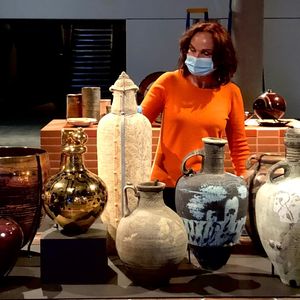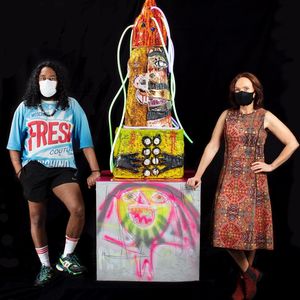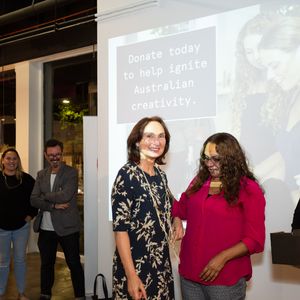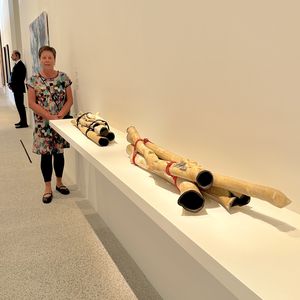Series 2 Episode 5: Museums and ceramics with Eva Czernis-Ryl
Clay Connections
/https://adc-2-prod.s3.amazonaws.com/media/dd/images/Eva__Bellarmine_Holding_Belarmine_by_Renee_So_in_Powerhous_photo_studio_.919e207.jpg)
Series 2: Clay connections
Episode 5: Museums and ceramics with Eva Czernis-Ryl
Show notes
Meet Powerhouse curator Eva Czernis-Ryl and hear:
- The skills of a museum curator
- How curators select and interpret objects
- What makes a work of ceramics suitable for a museum collection? and
- The unique history of ceramics collected by the Powerhouse.
And, hear ceramic artist and former editor of The Australian Journal of Ceramics Vicki Grima on setting up a ‘living bequest’ fund for ceramics.
Transcripts
Word document: Museums and ceramics with Eva Czernis-Ryl TRANSCRIPT S2 Ep5
PDF document: Museums and ceramics with Eva Czernis-Ryl TRANSCRIPT S2 Ep5
Guests
Eva Czernis-Ryl is an art and design historian and curator of Arts and Design at the Powerhouse in Sydney.
Vicki Grima, OAM, was the editor of The Journal of Australian Ceramics and CEO of the Australian Ceramics Association from 2005 to February 2023. She’s also a practicing ceramic artist.
Show highlights and takeaways
Clay Dynasty exhibition at Powerhouse, Sydney
Clay Dynasty (11 October 2021 – 5 March 2023) was the first major exhibition to chart ceramic practice across Australia, including objects from the collection and new acquisitions. The curator, Eva Czernis-Ryl, points out that it’s not a survey exhibition, but rather a collection based exhibition that focuses on the last five decades of studio ceramics in Australia.
How Eva became a museum curator
After studying art history and curatorship in Poland, Eva was hired as a research assistant to develop the first exhibitions for the new Powerhouse Museum [in Ultimo, Sydney]. Before the doors opened in 1988, she was made a curator and has continued there as Curator of Arts and Design.
The Powerhouse’s long history of collecting ceramics
Ceramics have always been at the front and centre of collecting at the Powerhouse, right from the beginning when it was established in 1879 as a result of the Sydney International Exhibition. Eva explains that the museum collected ceramics to educate the local pottery industry what you can make from clay. And as it happened, the ceramics collected were created in studios handmade by men and women.
The essential features of a museum curator
Eva picks curiosity, knowledge, being open and flexible as important qualities for a museum curator.
The importance of people and networks
She also highlights the importance of curiosity about people.
“When you work in the museum, you work with objects, but objects are made by people. So, curiosity about not only about objects, how they were made, why they were made, but also about people behind them, And then I think about how the people who made those objects would like this object to be presented.”
The curatorial eye
“Everybody has a different curatorial eye,” Eva says. “And inevitably, even though you try as much as you can to be impartial, you always go for your instinct.”
“Each part of the collection that is formed by a specific curator has a specific flavour. It’s inevitable that you respond to it in your personal way.”
Collection content
When curating an exhibition, Eva says that mostly she’ll be looking at what's in the collection, and what she’d like to show and say in the exhibition.
“You have the long term vision, and you have your specific immediate aims. “
Ceramics are one of the oldest forms of artistic expressions
Ceramics originated before Neolithic Period, and one of the oldest, known figurines is this amazing Venus of Dolní Věstonice which is a region in Moravia, in today's Czech Republic.
Objects as amazingly rich documents of our lives
Eva emphasises how objects are such a rich source of knowledge about who we are, where we've been, where we are going. She says this applies to both historical and contemporary ceramics.
“When you look at contemporary ceramics, the ceramics reveal not only about a particular individual who has made the object, but also about the context of our time.”
“Clay is here to stay”
Eva observes that there’s an amazing revival of interest in ceramics, globally. She doesn’t think that ceramics as a phenomenon is going to pass. As they say, "Clay is here to stay."
Vicki Grima’s ceramics bequest to a major institution
Vicki Grima has donated $100 000, in two lots of $50,000, to the Art Gallery of New South Wales, with the aim for that money to be spent on collecting contemporary Australian ceramics.
Why a ceramics fund?
Vicki says that two things coincided.
Firstly, she was updating her will and wanted to work out how to set up a donation to buy Australian ceramics and put it into a gallery. And secondly, in 2018, I was listening to this podcast, Tales of a Red Clay Rambler, on which artist Glenn Barkley was speaking.
In the podcast episode, Glenn said “You know, if I had a hundred grand I could start a ceramics collection in one of these big institutions that's been basically ignoring ceramics for decades.”
Vicki’s ears pricked up, even though she didn't have a hundred grand floating around. She started thinking about how she could make it happen. In May 2019 she donated the first $50,000.
Only ceramic work by Australian citizens or residents
The only guidelines I would put on it was that all the ceramic work had to be made in Australia by Australian citizens or an Australian resident. She wanted the money to be used to buy several pieces rather than one piece.
Connections to the existing AGNSW collection
Glenn [Barkley] looked at what ceramics would be bought with a donation that would compliment the Art Gallery of New South Wales collection. One of the pieces the Vicki Grima Ceramics Fund bought was Yasmin Smith's Bundle of Ntaria branches 8.
Vicki says that this work has strong links to several works in the Art Gallery of New South Wales collection, including Jonathan Jones’ called untitled (illuminated tree) and works by Noreen Hudson.
Lack of Australian contemporary ceramics in collections
Vicki says that the ceramics fund she created was quite a personal commitment to something I'd seen happening for a long time - the lack of Australian contemporary ceramics in places like the Art Gallery of New South Wales.
In traveling around Australia she’d also noticed that lots of regional galleries had stopped buying contemporary craft.
What makes a work suitable for a museum collection?
Eva Czernis-Ryl says that in terms of museums and galleries, there are collection development policies with specific criteria.
But it's up to the curator to keep watching what’s happening in the field, to read, travel and endeavour to know the field.
She also remarks that “Museum collections are vital organisms. They have this lively tendency towards uneven growth.”
Clay Dynasty exhibition: 400 objects by 160 artists
Eva says that through the Powerhouse’s Clay Dynasty exhibition, the Powerhouse acquired 70 new objects for their collection, with many being new commissions from artists. These commissions were by women and men ceramicists working across Australia from all the states.
The exhibition displayed 400 objects by 160 artists.
Eva says the exhibition also showcased the amazing networks and community in Australian ceramics.
She explains why the exhibition was called Clay Dynasty: “It's the network of potters who have worked for three generations, either continuous tradition or rejecting it, which I also see as a continuation, and you can see the rich range of designs and approaches.”
An ceramic object that Eva treasures
One object that I treasure and it's sitting on the shelf, on the bookshelf in my studio is a pot, a beautiful green pot by the great Merran Esson.
Eva says Merran often made very large pots that responded to the beauty of the Australian landscape. She is very well known for developing this rich green glaze, that in a way, reminds her of spring fields.
The context of an object
Eva says the green makes her remember the first time when I flew over Australia, and seeing Australian fields out the plane window.
This small Merran Esson pot reminds Eva of Merran’s amazing achievements as a teacher, of how warm and generous she was and how she got this pot because Merran donated it to an exhibition that was to raise funds for bushfires in Australia.
Eva explains that is the context of this object, reflective of all objects having rich contexts.
“I think about how it sits along the other pots by other people, and I can see the stories and how they relate to each other.
So I look at all these pots. And they sit in a row and look at me. And I look at them and I feel I'm at home.”
CREDITS
Object is a podcast of the Australian Design Centre. We'd like to thank Visions of Australia, the Federal government’s regional exhibition touring program for funding support towards this podcast.
Object is hosted by Lisa Cahill and produced by Jane Curtis, with production support from Alix Fiveash. Sound Engineering is by John Jacobs.
Return to Object: stories of design and craft main page.

/https://adc-2-prod.s3.amazonaws.com/media/dd/images/Eva__Bellarmine_Holding_Belarmine_by_Renee_So_in_Powerhous_photo_studio_.919e207.jpg)



